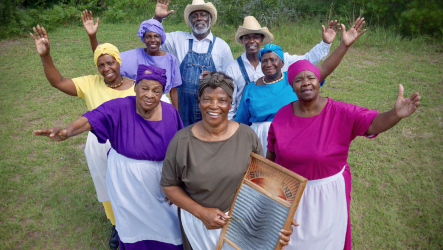- Lesson Plan (4)
- Student Activities (1)
- Castillo de San Marcos National Monument (1)
- Cumberland Island National Seashore (1)
- Fort Frederica National Monument (1)
- Glacier National Park (1)
- New Orleans Jazz National Historical Park (1)
- Reconstruction Era National Historical Park (1)
- Roger Williams National Memorial (1)
- Timucuan Ecological & Historic Preserve (1)
- Walnut Canyon National Monument (1)
- Show More ...
- Social Studies (3)
- Literacy and Language Arts (2)
- Math (1)
- Science (1)
- 11-12.RH.1 (1)
- 11-12.RH.2 (1)
- 11-12.RH.6 (1)
- 11-12.RH.7 (1)
- 11-12.RH.9 (1)
- 9-10.RI.2 (1)
Showing 5 results for Ring Shout ...
- Type: Lesson Plan
- Grade Levels: Upper Elementary: Third Grade through Fifth Grade

In this lesson students will learn about tree rings and how archaeologists use them to help date sites and artifacts. What are tree rings? How are tree rings used to determine the age of archaeological sites? Students will... ●Understand how trees grow and why growth rings are formed. ●Describe how climate and weather affects the growth of tree rings. ●Explain the age of a tree by its rings. ●Understand how ring patterns can be used to determine the age of archaeological sites.
- Type: Lesson Plan
- Grade Levels: Middle School: Sixth Grade through Eighth Grade

The Gullah Geechee are African Americans with ancestral roots in the Southeastern U.S., from southeastern North Carolina all the way down to northeastern Florida. Their ancestors, taken from West and Central Africa between the early 1600s and the 1850s, were forced into labor due to their skills and strength. To preserve their heritage, they created the Gullah Geechee language by blending native African languages with English.
It Was a Very Good Year
Circles in the Snow
- Type: Student Activities
- Grade Levels: Upper Elementary: Third Grade through Fifth Grade

The goals of this activity include: - Students will be able to identify a tipi ring and explain what it means; tell the story of what happened to two Cheyenne women in Black Kettle's camp during the November 27, 1868 attack; and critically analyze and discuss why the soldier chose to disobey orders.
Roger Williams and the Separation of Church and State
- Type: Lesson Plan
- Grade Levels: High School: Ninth Grade through Twelfth Grade

Roger Williams believed in the idea that religion was a matter of individual conscience, not to be regulated or supported by a government. In this lesson students examine both sides of the issue of a proposed RI bill that would provide tax supported school vouchers for private schools. The students will research the issue using primary and secondary sources and then participate in a debate to answer the question: Do school vouchers violate the principle of the separation of church and state?

